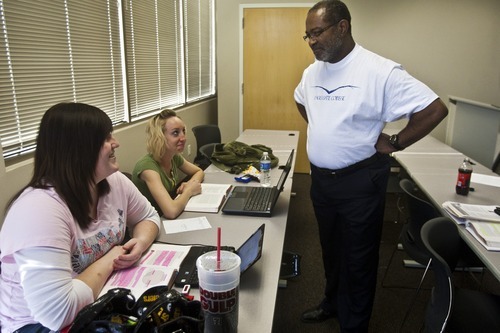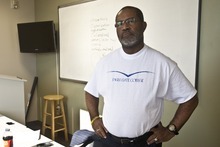This is an archived article that was published on sltrib.com in 2011, and information in the article may be outdated. It is provided only for personal research purposes and may not be reprinted.
When gangs arrived in Utah in the late 1980s, Ron Stallworth realized the state had a problem that would only grow bigger.
He had started his career policing outlaw motorcycle gangs with the Colorado Springs Police Department. He went on to watch the Los Angeles-based Blood and Crip gangs infiltrate Arizona while working as an agent in Phoenix. And when he arrived in Salt Lake City in 1987, he spent two years researching gangs as an investigator with the Utah Department of Public Safety after noticing an influx of Crips, crack-cocaine and gang-related crime in Ogden.
Stallworth drafted a report that led to the creation of the first gang task force in Salt Lake City in 1989. A year later, he helped create the Salt Lake County Area Gang Project, the state's first multijurisdictional gang suppression unit.
Twenty years after Stallworth first started training cops to better recognize the warning signs of gangs — along with helping to implement anti-gang strategies in communities around the state —the 57-year-old Layton resident is bringing his expertise to Davis County.
Davis County Attorney Troy Rawlings recruited Stallworth to become the county's new gang intelligence consultant after observing an increase in gang-related prosecutions. While the county is aware there is a gang presence, Rawlings said he is worried some of the county's police agencies aren't documenting crimes as gang-related, leaving prosecutors without an avenue to charge gang enhancements to crimes.
"When people come to court, I want my prosecutors to know if they are gang-affiliated," Rawlings said. "My ultimate objective is to send the message in the way we handle cases that gang-related crime and membership won't be tolerated in the county."
Stallworth recently started working part time to help law enforcement improve skills in gang investigations.
From forming Utah's earliest gang units from the ground up to becoming a nationally renowned lecturer on street gang culture and author of four books on the subject, Stallworth is fueled by wanting to prevent families from witnessing the heartache he has seen firsthand.
While traveling around the country from 1992 to 2000 to speak to officers at gang conferences, Stallworth hit the streets with local gang cops to get a flavor for how different cities' gang issues compared with Utah's problem. In Los Angeles, he arrived at the scene of a gang shooting, then held the hand of a man shot in the chest as the victim drew his last breath.
"That was the very first time I saw someone die form a gunshot wound," Stallworth recalled. "I remember asking myself, 10, 15, 30 minutes ago this guy had a life of some kind. He may have been doing dirt in the street, but he had a life of some kind. And I remember holding his hand and asking myself, I wonder what that life was like? Does he have a family? Does he have children? What's going to happen to them right now?"
Stallworth said in Davis County, he will use the concept of community-oriented policing, in which police go to the homes of suspected young gang members to talk to parents about what their children are involved in. His duties will include participating in multiagency gang intelligence meetings, educating prosecutors about the nature of gangs, and working to help the Davis County Jail in photographing and documenting gang tattoos.
Yet Stallworth will need to persuade some in Davis County that the region has a gang problem in the first place — an argument he's had to sell to many Utahns over the years. When Salt Lake City jumped on its gang problem in 1989, it aggressively policed gangs on its streets. But the Salt Lake County Sheriff's Department in the late 1980s was reluctant to admit gangs were marking their territory — resulting in a disconnect between agencies that needed to work together, he said.
He is hopeful history won't repeat itself.
"If the community doesn't buy into what we're saying, we can't win this battle," Stallworth said. "But I'm convinced we can turn the tide and we can accomplish the same thing that has happened in Salt Lake City."
Stallworth said it's clear there is a gang presence in Davis County because graffiti on buildings and fences indicate respective gang affiliations. Graffiti can escalate into other issues.
"If you don't address that graffiti problem, your community slowly starts to deteriorate," Stallworth said. "People don't want to live in certain neighborhoods, businesses don't want to come in."
Rawlings is hesitant to cite numbers of documented gangsters in the county, in part because a big part of Stallworth's job will be to help develop accurate numbers to outline the county's problem. A March report suggested the county is home to 23 distinct gangs with more than 200 members, he said.
Davis County gang prosecutions have increased significantly in the past five years, and particularly in the past two, Rawlings said.
An August trial is pending for Manuel Jimenez, a known gang member accused of putting out a hit on an informant who helped put Jimenez behind bars for gang-related crime. Jimenez, 37, was allegedly in the Davis County Jail while organizing the murder-for-hire plot and is charged with first-degree felony criminal solicitation.
Another suspected gang member accused of committing murder in Davis County is Joseph Allen Nance. The 28-year-old man was charged for shooting and killing his father at a Kaysville motel in March, and while the crime wasn't believed to be gang-related, the culture Nance surrounded himself with may have encouraged violence, police have said.
Rawlings wants to keep gang crime from mushrooming into an unmanageable problem, he said.
"Are we gang-infested? Not at all. We're trying to prevent that from happening; to weed out the gang encroachment that we have."
mrogers@sltrib.comTwitter: mrogers_trib —
Davis County's new gang consultant touts impressive resume
Ron Stallworth spent 32 years in law enforcement in Colorado, Arizona, Wyoming and Utah before retiring in 2005. The Davis County Attorney's Office this spring lured him out of retirement with a part-time position as a gang intelligence consultant. Some highlights of Stallworth's career include:
Testified before Congress three times about the country's gang problem, in particular how rap music plays a role in gang culture.
Works as an adjunct criminal instructor at Salt Lake Community College and Eagle Gate College in Layton.
2008-current • Co-chairs the Salt Lake City Gang Reduction Steering Committee, organized by Mayor Ralph Becker. The group is working to implement a nationally recognized "comprehensive gang model," which calls for grass-roots volunteer organizations, law enforcement and the courts to work together through a mix of programs and community activities to help gang-involved youth. The city is in the process of hiring gang outreach workers to implement the initiative.
1993-2000 • Served as gang intelligence coordinator for Utah, a position created for him by the Utah public safety commissioner.
1992-2000 • Traveled across the country lecturing on street gang culture and gang mentality. Also authored four books.
1990 • Helped start what is today the Salt Lake Area Gang Project/Metro Gang Unit, the first multi-jurisdictional gang suppression unit in the state.
1987-1989 • Worked as an undercover investigator with the Narcotics and Liquor Law Enforcement Bureau with the Utah Department of Public Safety. He conducted research on the state's gangs, and his report led to the first gang task force in Utah, a joint venture between the Utah Division of Investigation and Salt Lake City Police Department.
1981 • Worked on investigating Los Angeles-based Crip and Blood gangs while serving as an agent with the Arizona Criminal Intelligence Systems Agency in Phoenix.
1979-1980 • Led an undercover investigation into the Ku Klux Klan, where he infiltrated the KKK's Colorado Springs chapter. He still carries a David Duke-signed KKK card in his wallet.
1978-1979 • Investigated outlaw motorcycle gangs while assigned to the intelligence unit of the Colorado Springs Police Department.
1998 • Received the Frederick Milton Thrasher Award from the National Gang Crime Research Center for outstanding contributions to scholarship, service and innovation in gang research.







